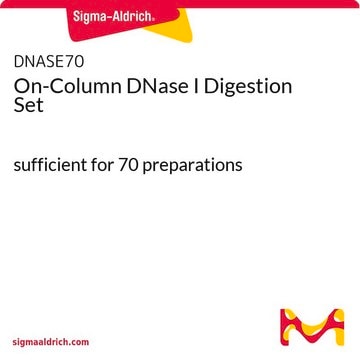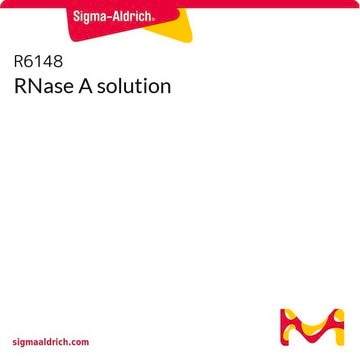D7291
Deoxyribonuclease I RNase-free solution from bovine pancreas
Synonim(y):
DNase I, Deoxyribonuclease I, pancreatic DNase I, pancreatic deoxyribonuclease I
About This Item
Polecane produkty
pochodzenie biologiczne
bovine pancreas
klasa czystości
for molecular biology
Postać
buffered aqueous glycerol solution
aktywność właściwa
10000 units/mg protein
masa cząsteczkowa
29.1 kDa
stężenie
5—15 mg protein/mL
metody
DNA extraction: suitable
przydatność
suitable for molecular biology
numer dostępu UniProt
Zastosowanie
cell analysis
obecność zanieczyszczeń
RNase, none detected
temp. przechowywania
−20°C
informacje o genach
cow ... DNASE1(282217)
Opis ogólny
Zastosowanie
Komponenty
Definicja jednostki
Inne uwagi
inhibitor
produkt powiązany
Hasło ostrzegawcze
Danger
Zwroty wskazujące rodzaj zagrożenia
Zwroty wskazujące środki ostrożności
Klasyfikacja zagrożeń
Resp. Sens. 1
Kod klasy składowania
11 - Combustible Solids
Klasa zagrożenia wodnego (WGK)
WGK 3
Temperatura zapłonu (°F)
Not applicable
Temperatura zapłonu (°C)
Not applicable
Środki ochrony indywidualnej
Eyeshields, Gloves, type N95 (US)
Certyfikaty analizy (CoA)
Poszukaj Certyfikaty analizy (CoA), wpisując numer partii/serii produktów. Numery serii i partii można znaleźć na etykiecie produktu po słowach „seria” lub „partia”.
Masz już ten produkt?
Dokumenty związane z niedawno zakupionymi produktami zostały zamieszczone w Bibliotece dokumentów.
Klienci oglądali również te produkty
Produkty
Use of MULTI-seq lipid-modified oligos, protocol, and troubleshooting guide for PCR Assays and Sequencing applications.
Zastosowanie oligos modyfikowanych lipidami MULTI-seq, protokół i przewodnik rozwiązywania problemów dla testów PCR i aplikacji sekwencjonowania.
Nasz zespół naukowców ma doświadczenie we wszystkich obszarach badań, w tym w naukach przyrodniczych, materiałoznawstwie, syntezie chemicznej, chromatografii, analityce i wielu innych dziedzinach.
Skontaktuj się z zespołem ds. pomocy technicznej









